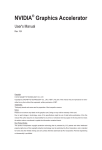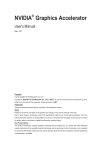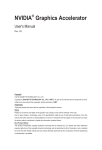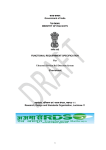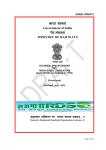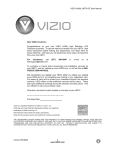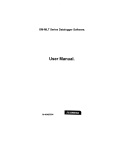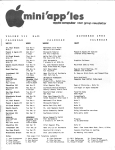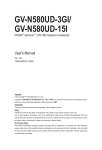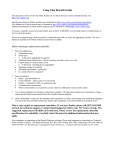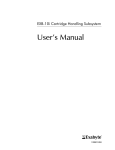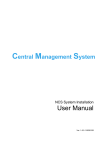Download Track Based Lubricators (Electronic & Hydraulic type) - rdso
Transcript
("
;;
3IT«I'
;a :tq; F(
Government of India
~ i:
"_I
Ii
MINISTRY OF RAILWAYS
-::»
~~<m
TECHNICAL
SPECIFICATIONS
FOR
TRACK BASED LUBRICATORS
(ELECTRONIC & HYDRAULIC TYPE)
(June 2013)
'-
"~.\~
'
-~.D.T.:a_.•
•.•
~ <""1
OC;;::c-E
,1lI -
3i
__
"!l
~
.:>
-1r'r:afl~sCOr~il~Jli~l1gI~aii'\?Vz:
"\.4"'U"".....,..,,~_it
~
ds~c>_g>Cll>"_Gi'l"B
vet
ys
.....•
AlafCfi ;8dloaf t'I&af31 - 11
Research, Design and Standards Organisation, Lucknow-ll
-.
Page 1 of 17
J
-_._------- --------_.
-_._--
-
,.
PREFACE
1.0
Para 427(2) of IRPWM provides that Rail flange lubricators should be provided
on curves of radius 600 meters and less on Broad Gauge to avoid Rail face
wear. Trial was undertaken with Hydraulic, electronic with AC power and
electronic with solar power lubricators on sharp curves in ghat sections.
Based on experience of trial and inputs from various stake holders, the
"Technical specification for Track Based Lubricators (Electronic & Hydraulic
Type) was prepared by ROSa.
2.0
The Basic dispensing system of lubricant is almost similar for both Electronic
and HyEiraulic types of lubricating systems. During Trial, it was observed
that electronic lubricators both with AC power and with solar power h a ve
exhibited better control in dispensing the lubricant resulting in lesser wastage
of lubricant compared to hydraulic type. AC powered electronic lubricators
can be provided on electrified routes, while Solar powered electronic
lubricators can be provided on other routes. Hydraulic type lubricators
may be provided preferably on sections having less GMT where electricity is
not available.
3.0
Railways shall undertake procurement of track mounted gauge face
lubricators as per their requirement to meet the provisions of IRPWM. The
gauge face lubrication on mild curves shall also be necessary in area where
Rail grinding is being done. While undertaking procurement, zonal railways
shall also ensure that
Adequate arrangement is made for Lubricant to be used with lubricators to
avoid idling. Performance Parameters of Lubricant to be used in Lubricators
have been laid down in the specification.
The availability of friction measurement equipment shall be ensured for
measurement of friction between rail and wheel to judge the efficacy of
lubricant and lubricators installed for the purpose.
Adequate arrangement of operation and maintenance of lubricators.
.:»
(i)
-
(ii)
(iii)
I
.. -
..
TECHNICAL
1.0
SPECIFICATION OF TRACK BASED LUBRICATORS
(Electronic Type)
SCOPE
This specification covers the description, functional and performance
parameters of electronic track based lubricators for gauge face lubrication.
The delivery system should be specifically designed to apply lubricant on
curves under different environmental
and traffic conditions on Indian
Railways.
2.0
DEVIATIONS
The tenderer shall furnish compliance or deviations, if any, for each clause
and
sub
clause
of
the
specifications
along
with
technical
explanations/details. The tenderer shall also furnish financial implications of
the deviations if any.
3.0
3.1
3.2
'--
3.3
3.4
4.0
SERVICE CONDITIONS
System should be able to work under following service conditions:
Ambient temperature
OOCto SOoC
ii
Rail temperature
(-) 10°C to (+) 7SoC
iii
Humidity
40-100%
iv
Rainfall
Fairly heavy
v
Atmospheric condition
Very dusty, heavy fog
On IR network the electrified traction consists of overhead electric
system of either 25000 V AC or 1S00 V DC with residual return
current passing through one of the rails in the track. The voltage for
track circuits for signaling purpose is up to 12 volts and the
corresponding current upto 1 amp. passes through the other rail.
The lubricator system should be able to work in above stated electric
traction and signaling system and its induction effect.
The lubricator system should be such that it does not affect the
signaling system.
The firm should offer proven technoloqy with lubricator and lubricant
supplied by them and working satisfactorily in any reputed railway
system of the world of similar environment prevailing in India.
Certificate in this regard from relevant railway system shall be
furnished.
DOCUMENTS
TO BE SUPPLIED
-J
i.
ii.
iii.
iv.
Installation Manual
Maintenance Manual
Service Manual
Part Manual
Page 2 of17
.:
5.0
6,0
FUNCTION
The applicator system should be an electrically powered pumping
system for delivering an adjustable quantity of lubricating material to
the rails in a manner such that passing wheels, either all or
nominated would carry the designed amount of lubricant along the
gauge face of rails.
SYSTEM DESCRIPTION
The application system must be proven system and should be
functional in all climatic conditions in India.
The application system should consist of a rail-mounted sensor, a
control box, an AC to DC converter or solar-charged battery, a
motor, a pump, a tank with a cover and a material distribution
system of hoses and applicators attached to the rails. The whole
system should be compatible with the lubricant as defined in para
8.0 of this specification.
The system should operate as passing wheels enter magnetic or
such field of the rail-mounted sensor. The sensor should transmit a
signal back to the control box. After counting the number of signals
from the sensor and when the pre-selected total is reached, the
control box should turn on the pump for the pre-selected duration.
The material should be pumped through a main hose to a central
distribution manifold where it may split into distribution hoses that
connect to the multi-ported applicators, clamped to the rail i.e. the
application of the lubricant to the rail should be of non-squirting type.
The product should then travel to the dispensing ports of each
applicator to deliver controlled amounts of product onto the rails.
The product should then be picked-up by passing train wheels. The
arrangement should be such that the optimum product distribution
take place both along circumference of wheel flange as well as
longitudinally along gauge face of rail.
'-...-
7.0
7.1
MAJOR COMPONENT SPECIFICATIONS
Wheel Sensor
Wheel passage should be determined by a disturbance to the
localized magnetic flux or such field established by the sensor.
Disturbance of the magnetic flux or such field should induce a
voltage signal indicating a passing wheel.
Assembly to the rail should not require machining of the rail.
The control circuit should be desiqnec to accept voltage signals for
speeds as low as 10 kmph and should be able to function properly
up to speed of 200 kmph.
Sensors should be available from the equipment manufacturer in
confiquration allowing for (1) bi-directional traffic without special
Page 3 of17
.J
.'
.
requirements, (2) for use in environments where stray currents from
power lines or buried cables may cause false detection of wheel
passage, and (3) single-direction traffic activation.
7.2
Power Supply
Application system should be designed to accommodate both direct
electrical connection to an AC power source, and to operate
independently using a solar panel and battery.
(a) AC Power
Unit should also be workable with 230 volts, SOHz. Supply. It
should be able to withstand voltage fluctuation in the range of
180-260 volts.
(b) Solar Power
The unit should be supplied with a solar panel and battery system.
The solar panel should be able to charge a sealed, deep-cycle ,
battery designed for extended use outdoors without high wattage
recharging. Erection of solar panel should be done in a manner so
as to prevent vandalism. To prevent theft / for protection of solar
panel it should be mounted on minimum 8.S meter high mast,
suitably protected by barbed wires or other suitable means. Solar
panel should also be protected against damage from brick batting
etc.
The solar panel post should be fixed on suitably designed
foundation and provided with lightening protection arrangement, if
required. Solar panel post should be enclosed / surrounded by
masonry wall with wire fencing on its top.
"---'
7.3
Electronic Control Circuit
The control circuit should serve to coordinate all operational
functions of applicators, meeting a wide variety of application needs
and conditions.
<:»
Specific performance and functional requirements are:
Operating Voltage:
Minimum 12 Volts DC
Circuiting Protection:
Minimum 1S-amp fuse
Operating Temperature:
Ambient temperature OOCto SOoC or Rail
Temperature (-) 10°C to (+) 7SoC.
Enclosures:
NEMA 4 Rated or equivalent.
Sensitivity:
Factory Set A 3.S Volts DC (may be adjusted
lower to accommodate slower speed trains,
with a corresponding sacrifice of accuracy.)
.j
Page 4 of17
.. ~"
Counter Circuit:
Should activate counter with every passage
of wheel. It should be possible to incorporate
a skip count feature to activate motor
selectively after passage of selected number
of wheels so as to minimize the consumption
of lubricant and maximize use of lubricant
applied.
Timer Circuit:
Should allow selection of variably timed
motor activation cycle for maximizing the
utilization of lubricant applied and minimize
its consumption. Circuit should also provide
for a constant setting used to prime the
system.
The control circuit should have the capability to operate the motor
for traffic in both directions or in a single direction when used with
the appropriate wheel sensor.
'''--"''
For security of the installation, the tank lid should be openable to
access the controls but duly locked. The vendor has to provide
satisfactory solution to make complete unit theft! vandalism proof
and safety against damage to any part of the equipment. The steel
tank containing the complete equipment including control panel etc.
should be enclosed in a suitably designed concrete! masonry room
having separate door with lock and key arrangements. The above
planning and execution of work is to be done by vendor himself
along with installation of the equipment. If required, vendor is to
submit the necessary drawings to comply this requirement.
The system should have separate controls to allow the selection of
the interval, based on wheel counts, between each activation and to
select the duration of the motor "on" cycle.
'-...--
The motor should be capable of activation on demand for
maintenance and test purposes.
A signal lamp should illuminate when motor is activated and another
to illuminate when the sensor is tripped.
It should have arrangement for anti-vandalism and anti-theft
features.
7.4
Electric Motor
The electric motor powering the pump should be directly coupled to
the pump and designed to operate on minimum 12 volts DC.
Electric motor should incorporate a suitable arrangement to
coordinate with the speed requirements of the pump.
Page 5 of17
.'
7.5
7.6
<::»
7.7
Pump
The pump should be efficient and compact It should require little
and easy maintenance and also easy to prime. Pump should be
capable of handling a wide range of viscosities, from the stiffest of
lubricant to the most fluid one. Pump should be able to produce
adequate minimum pressure required for pumping the desired
quantity of lubricant from the lubricant chamber to track rail gauge
face for various lifts/heights as per site conditions during passage of
train and to perform all the functions of gauge face lubricator. Pump
should be mounted in such a way that the pump's inlet port mates
directly to tank's outlet near bottom of tank. Between the pump and
material there should be a large mesh screen. The supplier will
submit the detailed specifications of pump for technical scrutiny of
the offer.
Lubricant Distribution System
Shut off valve or any other suitable lubricant distribution system
should be used to control the flow of lubricant to the applicators.
Distribution system should be efficient, able to distribute the
lubricant evenly. It should preferably have minimum moving parts. It
should require minimum and easy maintenance.
Hose
Hoses used with the application system should be connected via
screw-type connections to the tank and manifold.
Specific performance and functional requirements are:
'-----'
Outlet hose:
May be wire-braided.
Distribution hoses:
Must be non-conductive type hose.
Inner Tube:
Suitable Oil Resistant Material.
Cover Construction:
Suitable Oil Resistant Material.
Reinforcement:
Suitably reinforced.
Temperature Range:
Ambient temperature OOCto 50°C or Rail
Temperature (-) 10°C to (+) 75°C.
Burst Press Min.:
84.37 Kgf/ crrr' (1200 Psi)
Fittings:
Cast or forged brass alloy end fittings with
cast or spun brass ferrules.
Manifold valve handles should be removable for easy storage in the
dry chamber of the tank.
Distribution hoses should be long enough to supply applicators
mounted to the rails.
Page 6 of17
.,
7.8
Tank
Tank should be made of all welded steel construction and preferably
should include a separate section from the material to hold the
control box, power supply, and motor/pump etc. to improve
protection against vandalism.
Tank lid will include provisions for a locking mechanism to prevent
unauthorized access to the tank and controls.
Each tank should be fitted with a seal to prevent entry of any foreign
material, snow, sand, rain or other wind-born particulate matter.
This seal should have the arrangement to allow easy field
replacement, if necessary.
The bottom and sides of the tank should be such that it aids to easy
flow of material to the pump.
'---7.9
Tanks should include lifting lugs. The minimum capacity of the tank
should be 150 Kg for storage of lubricant.
Applicators
The application bars should clamp securely to the rail and be
adjustable for different sizes of rails being used in India and
distribution configurations. It should have coverage of minimum 2
Km with the recommended high quality rail-road lubricant.
Temperature range should be same as for hose.
All bars should mount to rail in such a way so as to minimize the
wastage of material from leakage around mounting.
The applicators should be multi-port configuration designed to
deposit material uniformly along the length of the applicator.
Internally, each applicator should incorporate passageways
designed so as to equally balance distribution from each port
opening. These passageways should be finished such as to
minimize sticking and clogging of material within the applicators.
'--.-Gauge face lubrication applicators should be mounted such that
gauge face lubricant is deposited onto the upper portion of the rail's
gauge face so as to come in contact with wheel flange.
8.0
LUBRICANT
A suitable lubricant for heavy rail road traffic should be used which is
compatible with the system. Its lubricity should be such that it
should provide friction value of 0.25 I.l or below. The carry down
effect should be minimum 2.0 kms. Carry down effect is the distance
from the location of lubricator, fixed in the track in the direction (s) of
rail traffic up to which lubricant should be carried by the wheel flange
effectively to reduce the rail wear and to fulfill all the performance
requirements mentioned in this specification.
Page 7 of17
:o-,~
.J
The lubricant should be non-inflammable, non-toxic and non-health
hazard. It should not give adverse effect on rolling stock
components and track components i.e. rails, sleepers, fastenings,
ballast etc.
Lubricant should be resistant to both water and high temperatures. It
should not get washed away in rain/ moist conditions and also
should not get softened or rundown during high temperatures
prevailing in the country.
,
The supplier will give detailed specifications of lubricant to comply
the above requirement and scrutiny of the offer. The supplier will
also furnish the average consumption rate of lubricant per actuating
wheel for all types of lubricant suitable for the equipment being
offered and their unit rates so that overall financial implication of the
lubrication system offered by the tenderer can be arrived at by the
tender committee.
'-----'
The supplier of the equipment should ensure continuous supply of
lubricant for at least three years for which a separate offer may be
given. No price variation shall be entertained for lubricants during
these three years.
Performance certificate for satisfactory service of the lubricant for
various functional requirements as stated above in similar
environment as prevailing in India must be submitted by tenderer/
supplier along with his offer. Such performance certificates should
be issued by relevant user railways.
9.0
9.1
DOCUMENTATION
Documentation of the track based lubricator system should be
supplied comprising of detail of diagram, electrical and electronic
designs with descriptions, component materials/part number,
equivalent international part number, component specification etc.
along with explanatory notes and comments wherever necessary.
9.2
Calibration, operation, maintenance and troubleshooting manuals
should be prepared in detail to the satisfaction of purchaser and
supplied in six copies each.
10.0
PERFOMANCE CERTIFICATE
The application system (Lubricator and Lubricant) must be proven
and should be functional in all climatic conditions in India.
Performance Certificates in this regard from user railway systems
shall be furnished by tenderer/ supplier along with the offer.
'-----"
\....-
.
.
/
Page 8 of17
11.0
11.1
SPARE PARTS
Expected life of components should be listed along with their
condemning limits. The component should be detailed in a separate
list indicating description, part number, quantity and whether
imported or indigenous.
11.2
The supplier should furnish list of components/spare parts which are
expected to be required for trouble free operation and maintenance
of the system for a period of 3 years after the warranty period
indicating their description, part number, equivalent international part
number, quantity and price. The price so quoted shall be valid for at
least two years after the expiry of warranty period. The purchaser
reserves the right to purchase these spares along with system
and/or after expiry of warranty period. The manufacturer shall also
guarantee availability of all required spare components to ensure
trouble free service for at least ten years after warranty. For parts to
be procured from the market, imported or indigenous, the sources
and details should be provided.
"-..-'
12.0
TOOLS
All
tools including
measuring
equipments
required for
diagnostics/fault finding and normal maintenance/repair should be
supplied as a complete kit. The list of such tools and equipments
proposed to be supplied with system should be furnished as a part
of maintenance/repair manual.
13.0
WARRANTY
13.1
13.2
The supplier should ensure that system supplied including all parts,
components etc. used is free from faults in manufacturing, design,
material, workmanship and should be of the highest quality and in
conformity with the contract specifications.
The warranty shall expire after 24 (twenty four) months from the
date of acceptance i.e. from the date of issue of commissioning
certificate after field validation of the system by purchaser.
<:>
13.3
Any part of the rail lubricating unit failing or proving unsatisfactory in
service due to defective design, material or workmanship within two
years from date of issue of commissioning certificate shall be
replaced by the suppliers at his own expense. In the event of
immobilization of rail lubrication unit owing to defect in design,
material or workmanship, this warranty period shall be extended for
the duration of the said period of immobilization. Further, should
any design modification be made in any part of the equipment
offered, the period of 24 months would commence from the date of
modified part is commissioned in service. The cost of such
modification shall be borne by the supplier.
Page 9 of17
%~~.
./
"---
13.4
The time limit for attending the defects during warranty period by the
service engineer of supplier is 10 days from the date of registering of
the complaint with him. A penalty of 1% of purchased price of the
equipment, per week or part thereof, shall be imposed for delayed
attention.
13.5
15% of the cost of the equipment shall be kept as "warranty bond"
with the Railways, which shall be refunded on the expiry of warranty
period. This can be in the form of bank guarantee also for the
requisite period.
14.0 SERVICE ENGINEERS
The supplier should provide at his own expense the services of
competent engineers during the warranty period for any
manufacturing and design defects. Service engineers should be
available for commissioning of rail lubricators for regular service, for
imparting instructions to operating, repair and maintenance as
mentioned in Para 16.3. These engineers should also advise the
railways on appropriate maintenance tests in operating, repair and
staff training facility.
15.0 INSPECTION
The inspection of rail lubricators shall be carried out by purchaser or
his authorized representative.
16.0 TRAINING
16.1 Supplier should provide adequate training to four Indian Railway
officials of Zonal Railway making procurement, in calibration,
operation, repair and maintenance of the system.
16.2
.-.....,/
The theoretical part of the training regarding repair and maintenance
including explanation, flow chart etc. shall be completed before
installation of system in the field.
16.3 A complete training programme covering system installation,
operation, troubleshooting and maintenance should be offered,
which shall be inclusive in the offer. This will be imparted during
installation or any other suitable time mutually agreed by Railway
Administration and the firm, to the satisfaction of Engineer Incharge.
16.4 In case any training is required abroad, the same should be
specifically mentioned giving details.
.
17.0 AMC
Annual Maintenance Contract (AMC) for a period of minimum three
years after completion of warranty period will be applicable.
Tenderer(s) will, however, quote the cost of AMC separately. Cost
of AMC for next five years i.e. "after warranty 3 years AMC" should
be offered separately. The AMC will be without spares. Cost of
spares and other details will be applicable as per Para"11..0of these
conditions.
Page
to
of
t7
;.
TECHNICAL SPECIFICATION
1.0
\.J
3.3
<:>
SCOPE
This specification covers the description, functional and performance
parameters of hydraulic track based lubricators for gauge face lubrication.
The delivery system should be specifically designed to apply lubricant on
curves under different environmental
and traffic conditions on Indian
Railways.
2.0
DEVIATIONS
The tenderer shall furnish compliance or deviations, if any, for each clause
and
sub
clause
of
the
specifications
along
with
technical
explanations/details. The tenderer shall also furnish financial implications of
the deviations if any.
3.0
SERVICE CONDITIONS
3.1
System should be able to work under following service conditions:
3.2
.-
OF TRACK BASED LUBRICATORS
(Hydraulic Type)
3.4
4.0
i.
ii.
iii.
iv.
Ambient temperature
OOCto SOOC
ii
Rail temperature
(-) 100C to (+) 7SoC
iii
iv
Humidity
Rainfall
40-100%
Fairly heavy
v
Atmospheric condition
Very dusty, heavy fog
On IR network the electrified traction consists of overhead electric
system of either 2S000 V AC or 1S00 V DC with residual return
current passing through one of the rails in the track. The voltage for
track circuits for signaling purpose is up to 12 volts and the
corresponding current upto 1 amp. passes through the other rail.
The lubricator system should be able to work in above stated electric
traction and signaling system and its induction effect
The lubricator system should be such that it does not affect the
signaling system.
The firm should offer proven technoloqy with lubricator and lubricant
supplied by them and working satisfactorily in any reputed railway
system of the world of similar environment prevailing in India.
Certificate in this regard from relevant railway system shall be
furnished.
DOCUMENTS
TO BE SUPPLIED
Installation Manual
Maintenance Manual
Service Manual
Parts Manual
'-
Page 11 of 17
----,-~
.
•J
,~
..: .
5.0
FUNCTION
The applicator system should be a hydraulically powered pumping system
for delivering an adjustable quantity of lubricating material to the rails in a
manner such that passing wheels, would carry the desired amount of
lubricant along the gauge face of rails.
6.0
SYSTEM DESCRIPTION
The application system must be proven system and should be functional in
all climatic conditions. in India.
The application system should consist of an actuator, a pump, a tank with
cover, and a material distribution system of hoses and applicators attached
to the rails. The whole system should be compatible with the lubricant as
defined in para 8.0 of this specification.
The material should be pumped through main hose to a central distribution
manifold where it may split into distribution hoses that connect to the multiported applicators clamped to the rail. The product should then travel to
the dispensing ports of each applicator to deliver controlled amounts of
product onto the rails. The product should then be picked-up by passing
train wheels.
The arrangement should be such that the optimum
distribution of the product takes place both along circumference of wheel
flange as well as longitudinally along gauge face of rails.
'-.../
7.0
MAJOR COMPONENT SPECIFICATIONS
7.1
Actuator
It should be easy to install and easy to remove for servicing. It should
operate through a closed loop hydraulic system that delivers consistent
pressure. While it should be a wheel actuated actuator, the conversion
of train wheel energy into the impulses of hydraulic power must be
independent of train wheel speed.
<:>
It should be adjustable to compensate for train speed and wear on head
of rails. Also it should be bi-directional.
7.2
Pump
It should be an efficient, compact and hydraulically powered motor
driving lubricant pump. It should require little maintenance and be easy
to prime. Pump should be capable of handling a wide range of
viscosities, from the stiffest of lubricant to the most fluid. Pump should
be able to produce adequate minimum pressure required for pumping
the desired quantity of lubricant from the lubricant chamber to track rail
gauge face for various lifts/heights as per site conditions during
passage of train and to perform all the functions of gauge face
lubricator. Pump should be mounted in such a way that the pump's inlet
port mates directly to tank's outlet near bottom of tank. Between the
Page 12 of17
,I
·.
pump and material there should be a large mesh screen. The supplier
will submit the detailed specifications of pump for technical scrutiny of
the offer.
7.3
Lubricant distribution system
Shut off valve or any other suitable lubricant distribution system
should be used to control the flow of lubricant to the applicators.
Distribution system should be efficient, able to distribute the
lubricant evenly. It should preferably have minimum moving parts. It
should require minimum and easy maintenance.
7.4
Hose
Hoses used with the application system should be connected via
screw-type connections to the tank and manifold.
Specific performance and functional requirements are:
Outlet hose:
May be wire-braided.
Distribution hoses:
Must be non-conductive type hose.
Inner Tube:
Suitable Oil Resistant Material.
Cover Construction:
Suitable Oil Resistant Material.
Reinforcement:
Suitably reinforced.
Temperature Range:
Ambient temperature OOCto 50°C or Rail
Temperature (-) 10°C to (+) 75°C.
Burst Press Min.:
84.37 Kgf/ cm2 (1200 PSI)
\..../
Fittings:
Cast or forged brass alloy end fittings with
cast or spun brass ferrules.
Manifold valve handles should be removable for easy storage in the
dry chamber of the tank.
<::
7.5
Distribution hoses should be long enough to supply applicators
mounted to the rails.
Tank
Tank should be made of all welded steel construction and preferably
should include a separate section from the material to hold the
control box, power supply, motor/pump etc. The vendor has to
provide satisfactory solution to make complete unit theft proof /
vandalism proof and safety against damage to any part of the
equipment. The steel tank containing the complete equipment
including control panel etc. should be enclosed in a suitably
designed concrete/ masonry room having separate door with lock
and key arrangements. The above planning and execution of work is
to be done by vendor himself along with installation of the
equipment. If required, vender is to submit the necessary drawings
to comply this requirement.
Page 13 of17
~
•..
,<1
Tank lid will include provisions for a locking mechanism to prevent
unauthorized access to the tank and controls.
Each tank should be fitted with a seal to prevent entry of any foreign
material, snow, sand, rain or other wind-born particulate matter.
This seal should have the arrangement to allow easy field
replacement, if necessary.
The bottom and sides of the tank should be such that it aids to easy
flow of material to the pump.
7.6
'--..--'
Tanks should include lifting lugs. The minimum capacity of the tank
should be 150 Kg for storage of lubricant.
Applicators
The application bars should clamp securely to the rail and be
adjustable for different sizes of rails being used in India and
distribution configurations. It should have coverage of minimum 2
Km with the recommended high quality rail-road lubricant.
Temperature range should be same as for hose.
All bars should mount to rail in such a way so as to minimize the
wastage of material from leakage around mounting.
The applicators should be multi-port configuration. designed to
deposit material uniformly along the length of the applicator.
Internally, each applicator should incorporate passageways
designed so as to equally balance distribution from each port
opening. These passageways should be finished such as to
minimize sticking and clogging of material within the applicators.
Gauge face lubrication applicators should be mounted such that
gauge face lubricant is deposited onto the upper portion of the rail's
gauge face so as to come in contact with wheel flange.
8.0
'-.../
LUBRICANT
A suitable lubricant for heavy rail road traffic should be used which
should be compatible with the system. Its lubricity should be such
that it should provide friction value of 0.25 IJ or below. The carry
down effect should be minimum 2.0 kms. Carry down effect is the
distance from the location of lubricator, fixed in the track in the
direction(s) of rail traffic up to which lubricant should be carried by
the wheel flange effectively to reduce the rail wear and to fulfill all
the performance requirements mentioned in this specification.
The lubricant should be non-inflammable, non-toxic and non-health
hazard. It should not give adverse effect on rolling stock
components and track components i.e. rails, sleepers, fastenings or
ballast.
.J
Page 14 of 17
______________________________
1
rf
"
-:t '"
Lubricant should be resistant to both water and high temperatures. It
should "not get washed away in rain/ moist conditions and also
should not get softened or rundown during high temperatures
prevailing in the country.
The supplier will give detailed specifications of lubricant to comply
the above requirement and scrutiny of the offer. The supplier will
also furnish the average consumption rate of lubricant per actuating
wheel for all types of lubricant suitable for the equipment being
offered and their unit rates so that overall financial implication of the
lubrication system offered by the tenderer can be arrived at by the
tender committee.
The supplier of the equipment should ensure continuous supply of
lubricant for at least three years for which a separate offer may be
given. No price variation shall be entertained for lubricants during
these three years.
~
Performance certificate for satisfactory service of the lubricant for
various functional requirements as stated above in similar
environment as prevailing in India must be submitted by tenderer/
supplier along with his offer. Such performance certificates should
be issued by relevant user railways.
~
9.0
DOCUMENTATION
9.1
Documentation of the track based lubricator system should be
supplied comprising of detail of diagram, hydraulic designs with
descriptions, component
materials/part
number, equivalent
international part number, component specification etc. along with
explanatory notes and comments wherever necessary.
Calibration, operation, maintenance and troubleshooting manuals
should be prepared in detail to the satisfaction of purchaser and
supplied in six copies each.
9.2
<:>
10.0 PERFOMANCE CERTIFICATE
The application system (Lubricator and Lubricant) must be proven
and should be functional in all climatic conditions in India.
Performance Certificates in this regard from user railway systems
shall be furnished by tenderer/ supplier along with the offer.
11.0 SPARE PARTS
11.1 Expected life of components should be listed along with their
condemning limits. The component should be detailed in a separate
list indicating description, part number, quantity and whether
imported or indigenous.
11.2 The supplier should furnish list of components/spare parts which are
expected to be required for trouble free operation and maintenance
of the system for a period of 3 years after the warranty period
indicating their description, part number, equivalent international part
number, quantity and price. The price so quoted shall be valid
Page 15 of 17
"
"'.
"
"
for at least two years after the expiry of warranty period. The
purchaser reserves the right to purchase these spares along with
system and/or after expiry of warranty period. The manufacturer
shall also guarantee availability of all required spare components to
ensure trouble free service for at least ten years after warranty. For
parts to be procured from the market, imported or indigenous, the
sources and details should be provided.
...•... /
12.0 TOOLS
All
tools
including
measuring equipments
required
for
diagnostics/fault finding and normal maintenance/repair should be
supplied as' a complete kit. The list of such tools and equipments
proposed to be supplied with system should be furnished as a part
of maintenance/repair manual.
13.0 WARRANTY
13.1 The supplier should ensure that system supplied including all
parts, components etc. used is free from manufacturing' and
faults in design, material, workmanship and should be of the
highest quality and in conformity with the contract
specifications.
13.2
The warranty shall expire after 24 (twenty four) months from
the date of acceptance i.e. from the date of issue of
commissioning certificate after field validation of the system by
purchaser.
13.3
<:>
Any part of the rail lubricating unit falling or proving
unsatisfactory in service due to defective design, material or
workmanship within two years from date of issue of
commissioning certificate shall be replaced by the suppliers at
his own expense.
In the event of immobilization of rail
lubrication unit owing to defect in design, material or
workmanship, this warranty period shall be extended for the
duration of the said period of immobilization. Further, should
any design modification be made in any part of the equipment
offered, the period of 24 months would commence from the
date of modified part is commissioned in service. The cost of
such modification shall be borne by the supplier.
13.4 The time limit for attending the defects during warranty period
by the service engineer of supplier is 10 days from the date of
registering of the complaint with him. A penalty of 1% of
purchased price of the equipment, per week or part thereof,
shall be imposed for delayed attention.
13.5 15% of the cost of the equipment shall be kept as "warranty
bond" with the Railways, which shall be refunded on the expiry
of warranty period. This can be in the form of bank guarantee
also for the requisite period.
Page 16 of17
"
:.'"
<
""---'
<.:'
••
14.0 SERVICE ENGINEERS
The supplier should provide at his own expense the services of
competent engineers during the warranty period for any
manufacturing and design defects. Service engineers should be
available for commissioning of rail lubricators for regular service, for
imparting instructions to operating, repair and maintenance as
mentioned in Para 16.3. These engineers should also advise the
railways on appropriate maintenance tests in operating, repair and
staff training facility.
15.0 INSPECTION
The inspection of rail lubricators shall be carried out by purchaser or
his authorized representative.
16.0 TRAINING
16.1 Supplier should provide adequate training to four Indian
Railway officials of Zonal Railway making procurement, in
calibration, operation, repair and maintenance of the system.
16.2 The theoretical part of the training regarding repair and
maintenance including explanation, flow chart etc. shall be
completed before installation of system in the field.
16.3 A complete training programme covering system installation,
operation, troubleshooting and maintenance should be offered,
which shall be inclusive in the offer. This will be imparted
during installation or any other suitable time mutually agreed by
Railway Administration and the firm, to the satisfaction of
Engineer In-charge.
16.4 In case any training is required abroad, the same should be
specifically mentioned giving details.
17.0 AMC
Annual Maintenance Contract (AMC) for a period of minimum three
years after completion of warranty period will be applicable.
Tenderer(s) will, however, quote the cost of AMC separately. Cost
of AMC for next five years i.e. "after warranty 3 years AMC" should
be offered separately. The AMC will be without spares. Cost of
spares and other details will be applicable as per Para 11.0 of these
conditions.
Page 17 of17


















